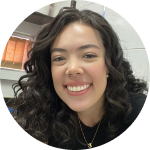Undergraduate students
Master students
 Maria Eduarda Sacre: Graduated with a degree in Chemistry Education from the Federal University of Espírito Santo (UFES). Currently pursuing a master’s degree in Analytical Chemistry at the Institute of Chemistry of São Carlos (IQSC-USP) and a member of the BioMicS research group. Her research focuses on analytical instrumentation, particularly the application of Liquid Chromatography coupled with Mass Spectrometry for compound determination, with an emphasis on cortisol quantification in hair samples.
Maria Eduarda Sacre: Graduated with a degree in Chemistry Education from the Federal University of Espírito Santo (UFES). Currently pursuing a master’s degree in Analytical Chemistry at the Institute of Chemistry of São Carlos (IQSC-USP) and a member of the BioMicS research group. Her research focuses on analytical instrumentation, particularly the application of Liquid Chromatography coupled with Mass Spectrometry for compound determination, with an emphasis on cortisol quantification in hair samples.
 Lucas Aguiar Neves: Master’s student at the Institute of Chemistry of São Carlos at the University of São Paulo (USP), conducting research in the field of colorimetric wearable biosensors. His work focuses on developing and applying sensors to detect biomarkers in human sweat, with an emphasis on identifying biomarkers associated with Alzheimer’s disease.
Lucas Aguiar Neves: Master’s student at the Institute of Chemistry of São Carlos at the University of São Paulo (USP), conducting research in the field of colorimetric wearable biosensors. His work focuses on developing and applying sensors to detect biomarkers in human sweat, with an emphasis on identifying biomarkers associated with Alzheimer’s disease.
PhD students
 Renata Santos: PhD candidate in Analytical Chemistry at the Institute of Chemistry of São Carlos at the University of São Paulo (USP). She began her doctorate with the BioMicS group in 2024, developing research in the miniaturization of Lab-on-a-Chip (LoC) systems. Her project focuses on developing a microfluidic device for detecting biomarkers in blood plasma to assist in liquid biopsy examinations.
Renata Santos: PhD candidate in Analytical Chemistry at the Institute of Chemistry of São Carlos at the University of São Paulo (USP). She began her doctorate with the BioMicS group in 2024, developing research in the miniaturization of Lab-on-a-Chip (LoC) systems. Her project focuses on developing a microfluidic device for detecting biomarkers in blood plasma to assist in liquid biopsy examinations.
Luíza Santa Brígida de Barros Góes: Graduated with a degree in Biological Sciences Education from the Federal University of Rio de Janeiro (UFRJ). Began her PhD in 2024 with the BioMicS group, working on the development of organ-on-a-chip microfluidic devices. Her research focuses on creating a multi-organ chip for drug testing, with applications in personalized medicine and as an alternative to animal experimentation.
Santa Brígida de Barros Góes: Graduated with a degree in Biological Sciences Education from the Federal University of Rio de Janeiro (UFRJ). Began her PhD in 2024 with the BioMicS group, working on the development of organ-on-a-chip microfluidic devices. Her research focuses on creating a multi-organ chip for drug testing, with applications in personalized medicine and as an alternative to animal experimentation.
Postdoctoral students
Eduardo Luiz Rossini: began his postdoctoral work in 2021, which involves the improvement of neonatal triage for innate diseases. The neonatal triage is considered one of the greatest advances in preventive medicine, because the early diagnosis of diseases reduces or eliminates irreversible sequels that could occur if they were not detected early on, even for rare diseases. Thus, Eduardo’s project aims to develop low cost neonatal triage devices that can overcome the irreproducibility problems of the currently used method. For that a microfluidic device in paper is fabricated, in which the plasma is separated from the blood. This creates dried plasma spots, which are analyzed by mass spectrometry, gold pattern for neonatal triage, through paper spray ionization, allowing the simplification of the analytical procedure, performing direct, fast and cheaper analysis, without the need of time consuming and laborious stages of sample preparation.
Mariana Bortholazzi Almeida: her work involves the identification of biomarkers related to the human health using omic analysis and the development of strategies for fast and low-cost diagnoses.
 Murilo Henrique Moreira Facure: Started his postdoctoral research with the BioMicS group in 2024. His project aims to produce flexible sensors from 2D materials with high electrical conductivity, such as graphene- and MXene-based materials. These sensors will be tested using electrical and/or electrochemical techniques to detect biologically relevant analytes indicative of human health, aiming for potential applications as wearable sensors.
Murilo Henrique Moreira Facure: Started his postdoctoral research with the BioMicS group in 2024. His project aims to produce flexible sensors from 2D materials with high electrical conductivity, such as graphene- and MXene-based materials. These sensors will be tested using electrical and/or electrochemical techniques to detect biologically relevant analytes indicative of human health, aiming for potential applications as wearable sensors.
Mikael Kélvin de Albuquerque Mendes: His research, supervised by Emanuel Carrilho (IQSC-USP) and Edivan Viera (UFPI), brings significant discoveries regarding the full utilization of cashew nuts (Anacardium occidentale L.) from 11 dwarf cashew clones developed by the Brazilian Agricultural Research Corporation (Embrapa).
Technicians
Claudia Bernal: PhD in Analytical Chemistry from IQSC, laboratory technician at IQSC since 2001, and member of the BioMicS group since 2018.


